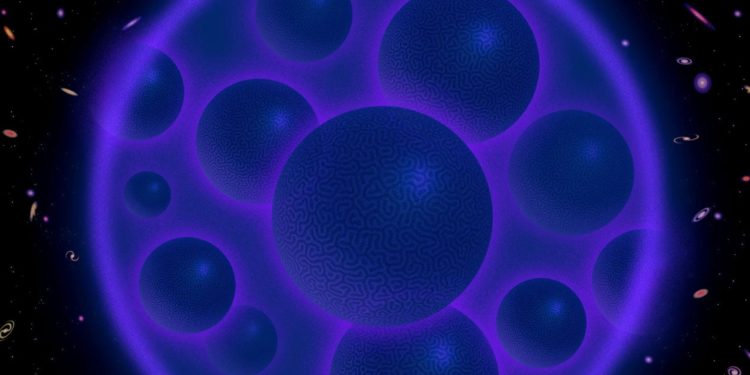By WIRED
But there may be opportunities to indirectly spot the signatures of those gravitons.
One strategy Vafa and his collaborators are pursuing draws on large-scale cosmological surveys that chart the distribution of galaxies and matter. In those distributions, there might be “small differences in clustering behavior,” Obied said, that would signal the presence of dark gravitons.
When heavier dark gravitons decay, they produce a pair of lighter dark gravitons with a combined mass that is slightly less than that of their parent particle. The missing mass is converted to kinetic energy (in keeping with Einstein’s formula, E = mc2), which gives the newly created gravitons a bit of a boost—a “kick velocity” that’s estimated to be about one-ten-thousandth of the speed of light.
These kick velocities, in turn, could affect how galaxies form. According to the standard cosmological model, galaxies start with a clump of matter whose gravitational pull attracts more matter. But gravitons with a sufficient kick velocity can escape this gravitational grip. If they do, the resulting galaxy will be slightly less massive than the standard cosmological model predicts. Astronomers can look for this difference.
Recent observations of cosmic structure from the Kilo-Degree Survey are so far consistent with the dark dimension: An analysis of data from that survey placed an upper bound on the kick velocity that was very close to the value predicted by Obied and his coauthors. A more stringent test will come from the Euclid space telescope, which launched last July.
Meanwhile, physicists are also planning to test the dark dimension idea in the laboratory. If gravity is leaking into a dark dimension that measures 1 micron across, one could, in principle, look for any deviations from the expected gravitational force between two objects separated by that same distance. It’s not an easy experiment to carry out, said Armin Shayeghi, a physicist at the Austrian Academy of Sciences who is conducting the test. But “there’s a simple reason for why we have to do this experiment,” he added: We won’t know how gravity behaves at such close distances until we look.
The closest measurement to date—carried out in 2020 at the University of Washington—involved a 52-micron separation between two test bodies. The Austrian group is hoping to eventually attain the 1-micron range predicted for the dark dimension.
While physicists find the dark dimension proposal intriguing, some are skeptical that it will work out. “Searching for extra dimensions through more precise experiments is a very interesting thing to do,” said Juan Maldacena, a physicist at the Institute for Advanced Study, “though I think that the probability of finding them is low.”
Joseph Conlon, a physicist at Oxford, shares that skepticism: “There are many ideas that would be important if true, but are probably not. This is one of them. The conjectures it is based on are somewhat ambitious, and I think the current evidence for them is rather weak.”
Of course, the weight of evidence can change, which is why we do experiments in the first place. The dark dimension proposal, if supported by upcoming tests, has the potential to bring us closer to understanding what dark matter is, how it is linked to both dark energy and gravity, and why gravity appears feeble compared to the other known forces. “Theorists are always trying to do this ‘tying together.’ The dark dimension is one of the most promising ideas I have heard in this direction,” Gopakumar said.
But in an ironic twist, the one thing the dark dimension hypothesis cannot explain is why the cosmological constant is so staggeringly small—a puzzling fact that essentially initiated this whole line of inquiry. “It’s true that this program does not explain that fact,” Vafa admitted. “But what we can say, drawing from this scenario, is that if lambda is small—and you spell out the consequences of that—a whole set of amazing things could fall into place.”
Original story reprinted with permission from Quanta Magazine, an editorially independent publication of the Simons Foundation whose mission is to enhance public understanding of science by covering research developments and trends in mathematics and the physical and life sciences.







Discussion about this post